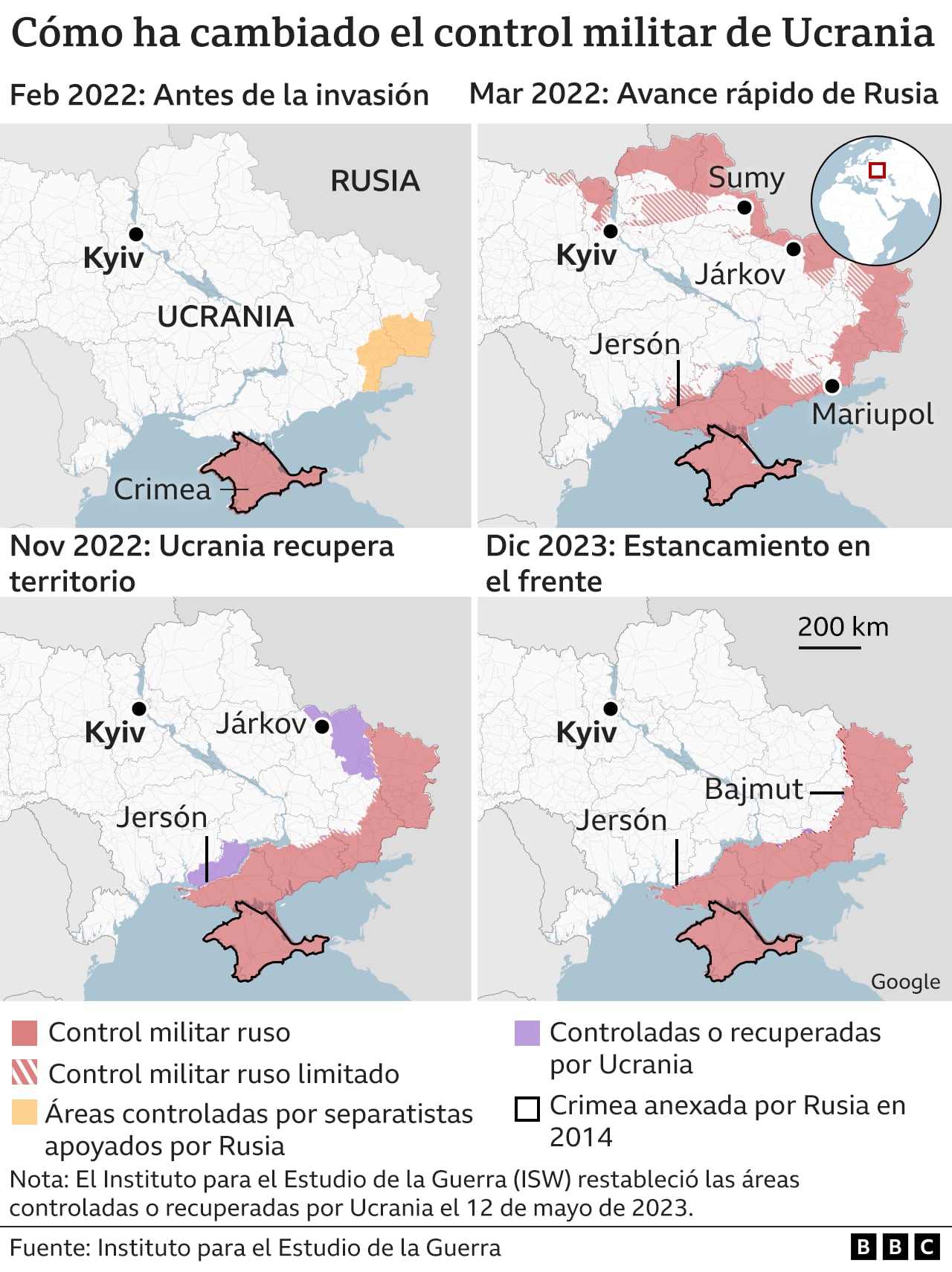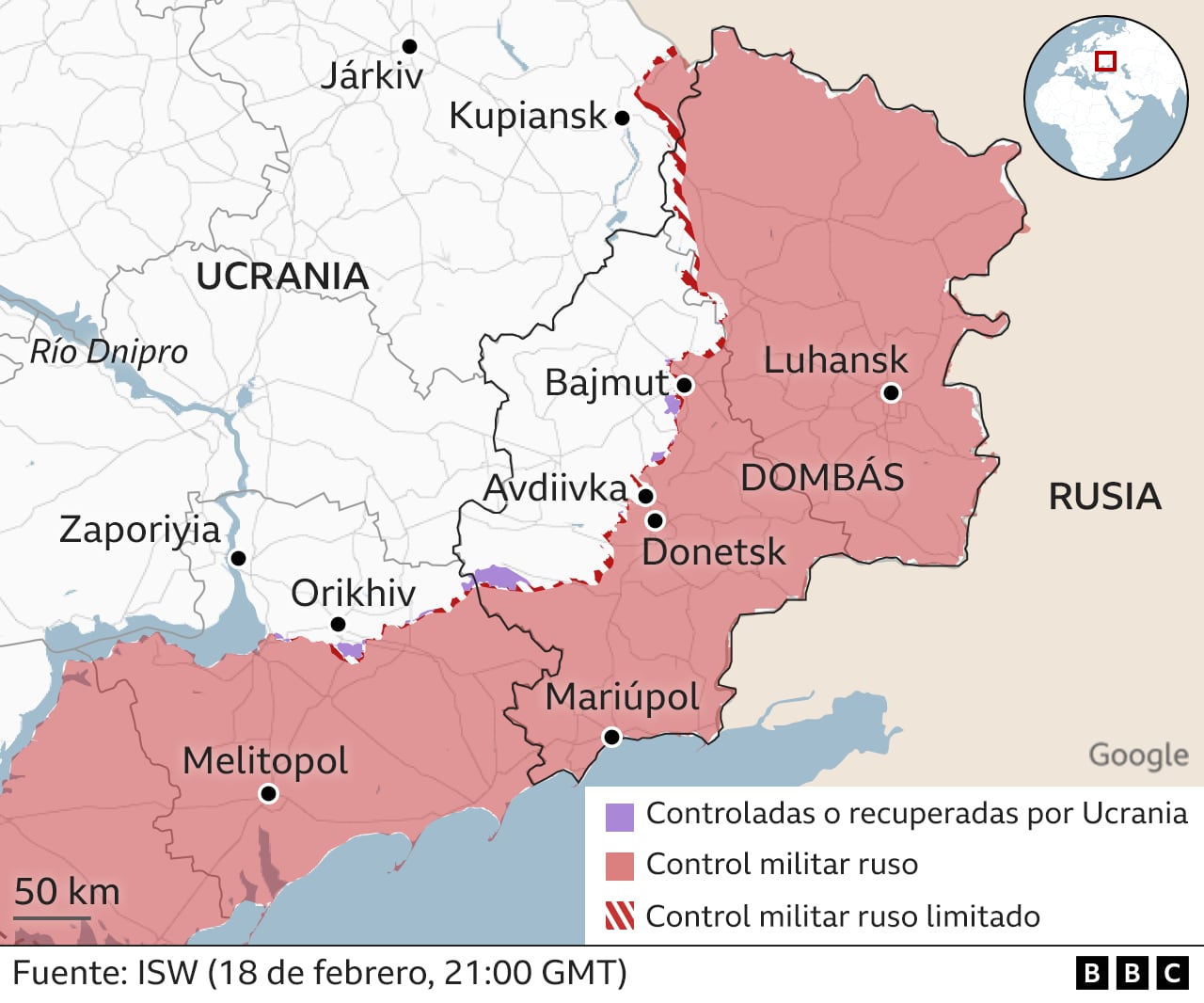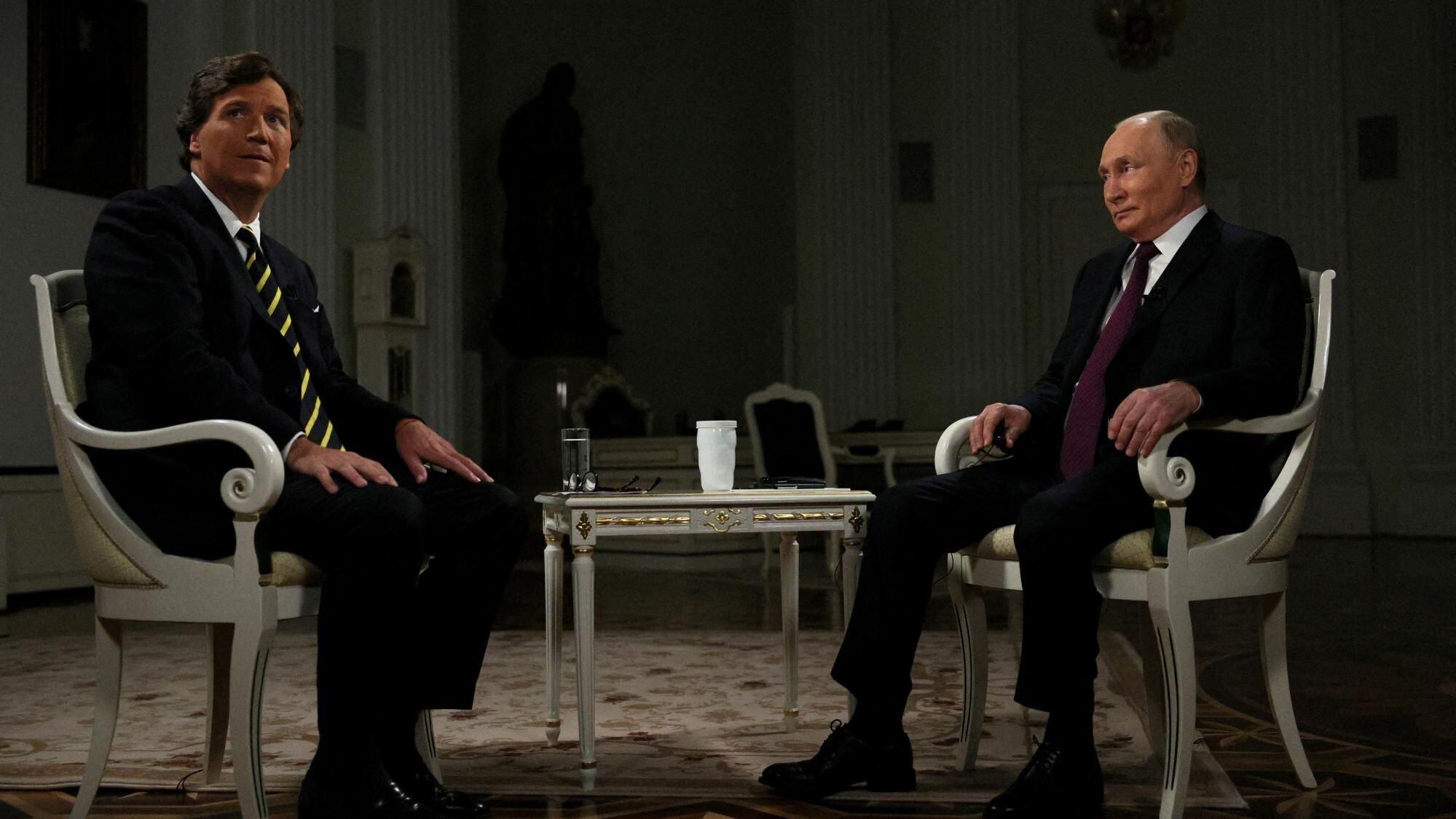Two years after the start of the war in Ukrainethere is no reason to believe that the conflict will end soon.
Neither Ukraine nor Russia, nor the main allies on either side, see grounds for a peace agreement.
LOOK: Project Islero, Franco’s Spain’s plan to get the atomic bomb and why it didn’t
Kiev insists that its internationally recognized borders must be restored and that it will expel Russian troops, while Moscow’s position remains that Ukraine is not a country and Russian forces will continue to apply pressure until their goals are achieved.
Below we see what is currently happening and where this conflict could go in the future.
1. Who is winning?
During the winter, fierce fighting took place that claimed many lives on both sides.
The front line stretches for 1,000 kilometers and its shape has changed little since autumn 2022.
Just months after the full-scale invasion two years ago, Ukraine repelled Russian forces from the north and around the capital, Kiev. That same year he retook large swathes of territory in the east and south.
But now, Russian forces are entrenched with powerful fortifications and the Ukrainians say they are running out of ammunition.

Many see a scenario of military stalemate, including both the recently ousted Ukrainian military commander-in-chief, Valerii Zaluzhnyi, and several pro-Kremlin Russian military bloggers.
In mid-February, Ukrainian troops withdrew from the city of Avdiivkain the east, which they fought for a long time ago.
Russian forces celebrated it as a major victory, as Avdiivka is strategically located and could potentially open routes for deeper invasions.
Kiev said the withdrawal was aimed at preserving the lives of its soldiers and did not hide that its forces were outnumbered and unarmed.
That was Russia’s biggest advance since capturing Bakhmut last May.
But Avdiivka is just 20 kilometers northwest of Donetsk, the Ukrainian city occupied by Russia since 2014.
Such a small advance is a far cry from Russia’s initial ambition in February 2022 to take Kiev “in three days”, which was shared by military bloggers and repeated by state propaganda.
At the time, around 18% of Ukrainian territory remains under Russian occupationincluding the Crimean peninsula annexed in 2014, and much of the Donetsk and Luhansk regions in the east, which Russia captured soon after.

2. Is support for Ukraine declining?
Over the past two years, Ukraine’s allies have sent it enormous amounts of military, financial and humanitarian aid: nearly $92 billion from European Union institutions and $73 billion from the United States through January 2024, according to the Kiel Institute for the World Economy.
Western-supplied tanks, air defenses, and long-range artillery They helped Ukraine substantially.
But the flow of aid has slowed in recent months amid debate over how long allies can realistically support Ukraine.
In the United States, a new $60 billion package is stalled in Congress, embroiled in internal political disputes.
And there is concern among Ukraine’s supporters that US support will wane if Donald Trump returns to the White House in November’s presidential election.
A $54 billion aid package was approved in the EU in February after many discussions and negotiations, especially with Hungary, whose prime minister, Victor Orban, He is a Putin ally who openly opposes support for Ukraine.
Furthermore, the EU is on track to deliver only about half of the million artillery rounds it intended to supply to Kiev by the end of March 2024.

Among Russia’s supporters is neighboring Belarus, whose territory and airspace have been used to access Ukraine.
Iran has been supplying Russia with Shahed drones, the US and EU say, although Iran only admits to supplying Russia with a small number of drones before the war.
Unmanned aerial vehicles (UAV) have proven effective in striking targets in Ukraine, in a war where drones are sought after by both sides for their ability to evade air defenses.
The sanctions did not work as well as Western countries had hoped and Russia has been able to continue selling its oil and obtaining parts and components for its military industry.
China is not believed to supply weapons to either side. In general, he followed a careful diplomatic line regarding this war, without condemning the Russian invasion, but also without supporting Moscow militarily, although both Beijing and India continued to buy Russian oil.
Both Russia and Ukraine have also made great efforts to court developing countries, with numerous diplomatic visits to Africa and Latin America.
3. Have Russia’s objectives changed?
Many believe that Russian President Vladimir Putin he still wants all of Ukraine.
In his recent interview with American presenter Tucker Carlson, the Russian president once again exposed his distorted view of history and the conflict.
He has long asserted, without offering solid evidence, that civilians in Ukraine, especially in the eastern region of Donbass, need Russian protection.

Before the war, he wrote a long essay in which he denied the existence of Ukraine as a sovereign state and said that Russians and Ukrainians were “one people.”
In December 2023, he said his goals because what Russia calls a “special military operation” has not changedincluding the “denazification” of Ukraine, which is based on unsubstantiated allegations about far-right influence in that country.
He also says he wants “demilitarization” and a “neutral” Ukraine, and continues to criticize the expansion of NATO influence eastward.
As an independent state, Ukraine has never belonged to any military alliance.
His political goals included membership of the European Union and he was in negotiations for a closer alliance with NATO, which now appears closer than at the start of the war.
These objectives sought to strengthen the state of Ukraine and protect it from being drawn into any geopolitical project to restore the Soviet Union in some way.
4. How could the war end?
With neither party likely to surrender and Putin determined to remain in power, analysts’ forecasts tend to assume a protracted war.
Global security think tank Globsec collected the opinions of dozens of experts to assess the likelihood of different outcomes.
Your most likely scenario It was a war of attrition that would last beyond 2025, with heavy casualties on both sides and Ukraine still dependent on arms supplies from its allies.
The second scenario included possible escalations of conflicts in other parts of the world, such as the Middle East, China-Taiwan and the Balkans, with Russia seeking to increase tensions.

Two other potential scenarios, both considered equally likely, were that Ukraine would make some military gains but no agreement would be reached to end the war, or that support from Ukraine’s allies would wane and put pressure on the country to reach a solution. negotiated.
However, it persists uncertainty about the potential impact of the US presidential election as well as how other wars, especially the conflict between Israel and Hamas, will affect the priorities and loyalties of Ukraine and Russia’s supporters.
5. Could the conflict spread further?
In mid-February, Ukrainian President Volodymyr Zelensky warned that keeping Ukraine in an “artificial deficit” of weapons would help Russia.
He told an international security conference in Munich that Putin would make the next few years “catastrophic” for many more countries if the Western world did not stand up to him.
The think tank Royal United Services Institute (Rusi) claims that Russia has successfully transitioned its economy and defense industry to large-scale military production and is preparing for a long war.
They claim that Europe is not keeping pace, a concern also raised by Poland’s Foreign Minister.
European countries – included in warnings from the German Foreign Minister and Estonian intelligence services – have recently expressed fears of that Russia could attack a NATO country in the next decade.
This has led NATO and the EU to intensify their future planning, both in terms of military capabilities and preparing societies to live in a very different world.
Source: Elcomercio
I am Jack Morton and I work in 24 News Recorder. I mostly cover world news and I have also authored 24 news recorder. I find this work highly interesting and it allows me to keep up with current events happening around the world.

:quality(75)/cloudfront-us-east-1.images.arcpublishing.com/elcomercio/6LYCQFOQARG4LEGGWSACCCTO7U.jpg)

:quality(75)/cloudfront-us-east-1.images.arcpublishing.com/elcomercio/IVPGMSGYDBFVPLL5POGCAB6KFA.jpg)
:quality(75)/cloudfront-us-east-1.images.arcpublishing.com/elcomercio/PYCEM4RBYJDV5DJG55SURDBNZU.jpg)
:quality(75)/cloudfront-us-east-1.images.arcpublishing.com/elcomercio/IRHJFEA6XNFS5L3ONJ6WT4BZVU.png)
:quality(75)/cloudfront-us-east-1.images.arcpublishing.com/elcomercio/Y4NGONWUNFHCHAED3HAD7RKL4A.jpg)
